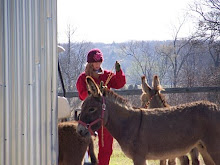Basically, aquaponics is a way to grow fish (that you can eat, if you choose) and veggies all in the same environment and they feed off of one another. That's about the best explanation that I can give, but if you want more, you can read Wikipedia's explanation here.
Anyway, I chronicled Tom's adventure in photos.
First, he bought this container called a tote. It's a big plastic bucket that comes in a steel crate. It must be "food grade", meaning that it hadn't previously carried something non-edible in it. This one happened to have transported maple syrup at one point. There's a big screw on lid on top and another spout at the bottom (which will later be used to drain the tank when necessary).
The first step was to cut the top off of the plastic container, then the solid bottom portion of the steel cage. Tom wore out his saw blades on the steel, so it's a pretty hefty contraption. He flipped the top upside down and put it in the bottom that he cut off.
This is what it looks like assembled. The bottom of the steel cage holds the top of the plastic tote, which has become the container for the plants to grow in. The top of the steel cage holds the bottom of the tote, which is filled with water for the fish. The lid is set on top of the water tank, offset several inches so that there is access to the fish when they are introduced into the system in about six weeks. This also allows for bugs to land in the water and get eaten by the fish.
Tom made this filter/drain thing out of PVC pipe. It fits into the hole where the top lid was screwed on. It's a double layer thing so that the middle white pipe can be lifted out and cleaned without having rocks fall through into the water tank.
Apparently, the plants are supposed to grow in rock rather than dirt. We scoured the area looking for rock that was not caustic. Crushed granite and expanded shale are recommended. We couldn't find any crushed granite, but we did find a couple of bags of expanded shale. Tom researched a little more and found that lava rock works, as well. So he put a mixture of the shale and lava rock into his system. Tip: caustic rock (such as limestone) will bubble and fizz when vinegar is poured on it. We carried a bottle of vinegar with us to test various rocks and some stone yards that we visited.
Into the water tank, he placed a small water pump, which is attached to the hose.
It pumps the water (which is fertilized by the fish) up into pipes on top, which carry the water, dispersing it evenly throughout the tray full of rocks.
If you look closely (or enlarge the picture by clicking on it) you can see the water dribbling out through the holes in the pipes.
After circulating through the rock and the (future) plant roots, the water is cleaned and pours back down through the drain in the middle into the fish tank. The water also carries nutrients from the plants back to the fish.
Tom has planted some seeds in the rocks, so now we wait. He's supposed to wait about six weeks to allow the plants time to prepare the water for the fish.















No comments:
Post a Comment